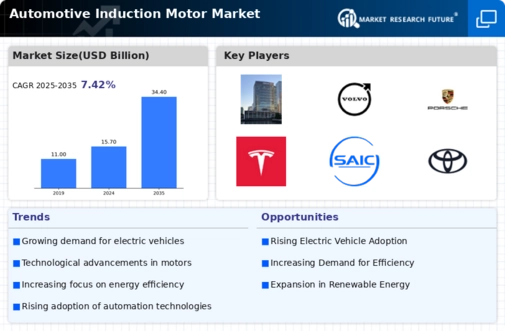Market Growth Projections
The Global Automotive Induction Motor Market Industry is projected to experience substantial growth, with estimates indicating a market value of 15.7 USD Billion in 2024 and a remarkable increase to 34.4 USD Billion by 2035. This growth trajectory suggests a compound annual growth rate (CAGR) of 7.42% from 2025 to 2035. Such projections highlight the increasing reliance on induction motors in the automotive sector, driven by factors such as the rise of electric vehicles, advancements in technology, and supportive government policies. The anticipated growth underscores the importance of induction motors in shaping the future of automotive propulsion.
Growing Demand for Electric Vehicles
The increasing global demand for electric vehicles (EVs) is a primary driver for the Global Automotive Induction Motor Market Industry. As consumers become more environmentally conscious, the shift towards EVs has accelerated, leading to a projected market value of 15.7 USD Billion in 2024. Induction motors are favored for their efficiency and reliability in EV applications. The transition to electric mobility is expected to continue, with the market anticipated to reach 34.4 USD Billion by 2035, reflecting a compound annual growth rate (CAGR) of 7.42% from 2025 to 2035. This trend underscores the pivotal role of induction motors in the automotive sector.
Government Regulations and Incentives
Government regulations aimed at reducing carbon emissions are driving the Global Automotive Induction Motor Market Industry. Many countries are implementing stringent emissions standards and offering incentives for the adoption of electric and hybrid vehicles. These policies encourage automotive manufacturers to invest in induction motor technology, which is essential for the performance of electric drivetrains. As a result, the market is experiencing a surge in demand, with projections indicating a market value of 15.7 USD Billion in 2024. The supportive regulatory environment is expected to foster innovation and investment in induction motor technologies, further propelling market growth.
Rising Fuel Prices and Economic Factors
Rising fuel prices and economic factors are contributing to the growth of the Global Automotive Induction Motor Market Industry. As consumers seek more cost-effective and fuel-efficient transportation options, the demand for electric vehicles equipped with induction motors is increasing. This shift is driven by the need to mitigate the financial burden of fuel costs, particularly in regions where fuel prices are volatile. Consequently, the market is projected to reach 34.4 USD Billion by 2035, with a CAGR of 7.42% from 2025 to 2035. Economic considerations are thus playing a crucial role in shaping consumer preferences towards electric mobility.
Technological Advancements in Motor Design
Technological advancements in the design and manufacturing of induction motors are significantly influencing the Global Automotive Induction Motor Market Industry. Innovations such as improved materials, enhanced cooling techniques, and advanced control systems are leading to more efficient and compact motor designs. These developments not only enhance performance but also reduce energy consumption, aligning with global sustainability goals. As manufacturers adopt these technologies, the efficiency of induction motors is expected to improve, thereby increasing their adoption in various automotive applications. This trend is likely to contribute to the overall growth of the market in the coming years.
Increased Investment in Research and Development
Increased investment in research and development (R&D) is a significant driver of the Global Automotive Induction Motor Market Industry. Automotive manufacturers are allocating substantial resources to innovate and improve induction motor technologies. This focus on R&D is aimed at enhancing motor efficiency, reducing costs, and integrating advanced features such as smart technology and connectivity. As a result, the market is expected to benefit from a continuous influx of innovative solutions that meet the evolving demands of consumers and regulatory bodies. This trend is likely to sustain the momentum of market growth in the foreseeable future.


























Leave a Comment